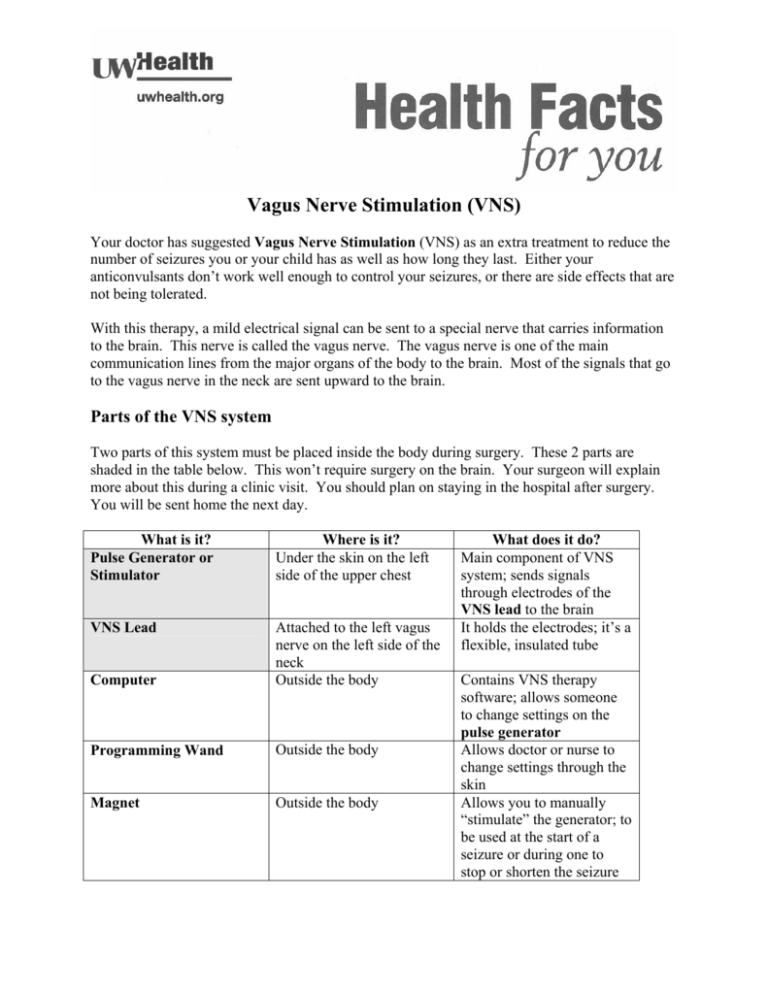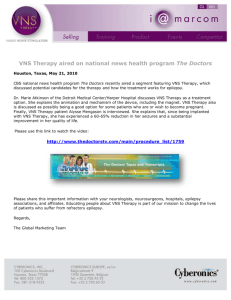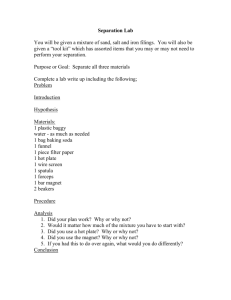
Vagus Nerve Stimulation (VNS)
Your doctor has suggested Vagus Nerve Stimulation (VNS) as an extra treatment to reduce the
number of seizures you or your child has as well as how long they last. Either your
anticonvulsants don’t work well enough to control your seizures, or there are side effects that are
not being tolerated.
With this therapy, a mild electrical signal can be sent to a special nerve that carries information
to the brain. This nerve is called the vagus nerve. The vagus nerve is one of the main
communication lines from the major organs of the body to the brain. Most of the signals that go
to the vagus nerve in the neck are sent upward to the brain.
Parts of the VNS system
Two parts of this system must be placed inside the body during surgery. These 2 parts are
shaded in the table below. This won’t require surgery on the brain. Your surgeon will explain
more about this during a clinic visit. You should plan on staying in the hospital after surgery.
You will be sent home the next day.
What is it?
Pulse Generator or
Stimulator
Where is it?
Under the skin on the left
side of the upper chest
VNS Lead
Computer
Attached to the left vagus
nerve on the left side of the
neck
Outside the body
Programming Wand
Outside the body
Magnet
Outside the body
What does it do?
Main component of VNS
system; sends signals
through electrodes of the
VNS lead to the brain
It holds the electrodes; it’s a
flexible, insulated tube
Contains VNS therapy
software; allows someone
to change settings on the
pulse generator
Allows doctor or nurse to
change settings through the
skin
Allows you to manually
“stimulate” the generator; to
be used at the start of a
seizure or during one to
stop or shorten the seizure
Pulse Generator or Stimulator Settings
The doctor will decide how to program the device so that it works best for you or your child.
There are settings for both continuous (“around the clock”) and magnet (“on demand”)
stimulation. Any changes to the settings will be made in the hospital or clinic.
Benefits of VNS therapy
VNS is not a cure for epilepsy. It also does not work for everyone. Yet, about one-third of
patients with VNS have a dramatic improvement in seizure control. One-third will have a good
improvement. Another one-third have little or no change in seizure control. We are not able to
predict how you or your child will respond, but many patients have had some benefits as listed
below.
less severe or shorter seizures
shorter or less severe symptoms after the seizure ends
more alert overall, improved memory and thinking
some eventually are able to reduce the dosage of their seizure medications
very few patients are able to stop medications completely
Side Effects
You may feel side effects at first from the VNS, but they will most likely become less noticeable
over time. The most common side effect is hoarseness. The other three most common side
effects are sore throat, shortness of breath, and coughing. These problems mostly occur only
during stimulation. If these symptoms are non-stop or uncomfortable, let your doctor know.
Other side effects that may be related to the VNS system:
Lack of coordination
Inability to sleep
Indigestion
Difficulty swallowing
Nausea
Pain
Vomiting
Throat spasms or tightness
Throat inflammation
Tooth pain
Hiccupping
Facial flushing
Call your doctor right away:
if you or your child develop any of these symptoms.
if stimulation becomes painful.
if any new symptoms develop that you feel are because of stimulation.
2
About the Magnet
There are 3 main reasons to use the magnet. We will also tell you how to use the magnet
for each reason.
1) Stop a seizure
This is the most common use for the magnet.
How?
If you or your child feels an aura or a seizure starting, start stimulation by holding
the magnet on the pulse generator for two seconds. If the seizure does not stop or
slow down, you can repeat this one, two, or three minutes after the first use. The
magnet may also be used in the middle of a seizure.
2) Temporarily turn OFF the pulse generator
This is done:
When you or your child plan to sing or speak in public (if stimulation causes a
change in your voice).
When eating (if there are swallowing problems).
If stimulation becomes painful or uncomfortable.
How?
Place the magnet over the pulse generator. Hold it there, or tape it in place for as
long as you want the stimulation stopped. As soon as the magnet is removed, the
regular stimulation cycle will restart.
3) Check if the pulse generator is working
Your doctor will do this at an office visit.
Cautions about handling the magnet
Do not drop the magnets. They can break if dropped on a hard surface.
Carry a magnet with you at all times. Show caregivers how and when to use the
magnet.
Never store magnets near credit cards, computers, computer discs, watches, or
other magnets. Keep them at least 10 inches away. The reason for this is the
magnet may cause damage to these items.
Do not sleep with the magnet on your wrist. Moving around during the night can
place the magnet over the generator for long periods of time by mistake.
Avoid excessive vagus nerve stimulation. This happens when using the magnet for
more than four hours of constant stimulation.
3
Using other magnets
Only the magnet given to you from the Cyberonics Company should be used with your
VNS. If you lose or break your magnet, order another one from Cyberonics. In an
emergency, you can try other strong magnets. The use of other magnets will not harm the
device.
Hazards
Unsafe
Environmental hazards
Strong magnets, hair clippers,
vibrators, loudspeakers, and
similar electromechanical devices
can cause the pulse generator to
start suddenly
Transmitting antennas may
interfere with the VNS
More
safe
Small appliances like microwave
ovens, toasters, hair dryers,
electric shavers should not affect
the pulse generator
Cellular phones do not affect the
pulse generator
Properly working electrical
ignition systems and power
transmission lines should not
affect the pulse generator
Antitheft devices and metal
detectors should not affect the
pulse generator
4
Medical hazards
Treatment with radiation, cobalt
machines, and linear accelerators
may damage the pulse generator
MRI should not be performed
with a body coil in transmit mode
The pulse generator (including
magnet output setting) must be
turned off before MRI and
surgery.
External cardiac defibrillation,
diathermy, electrocautery, and
extracorporeal shockwave
lithotripsy may damage the pulse
generator
The pulse generator may affect
the operation of cardiac
pacemakers and implantable
defibrillators
Avoid any therapeutic ultrasound
treatment since heat may be
concentrated by the device
Most routine diagnostic
procedures should not affect the
pulse generator
Special positioning during
mammography may be needed
for a clearer image
About the Pulse Generator Battery
Battery life ranges from 6.5 to 10 years if used at normal settings. It will lose its power
over time. When this happens, it will begin to stimulate differently. You may notice an
increase in the number of seizures, how severe they are, and how long they last. Seizures
may increase to the level they were before the VNS was placed. Call your doctor if you
suspect this has happened. Your doctor will discuss with you the benefits of VNS and
whether the pulse generator should be replaced.
If you have questions about VNS and your seizure control, ask your neurologist.
Copyright © 1/2013. University of Wisconsin Hospitals and Clinics Authority. All rights reserved.
Produced by the Department of Nursing HF#6143
5








